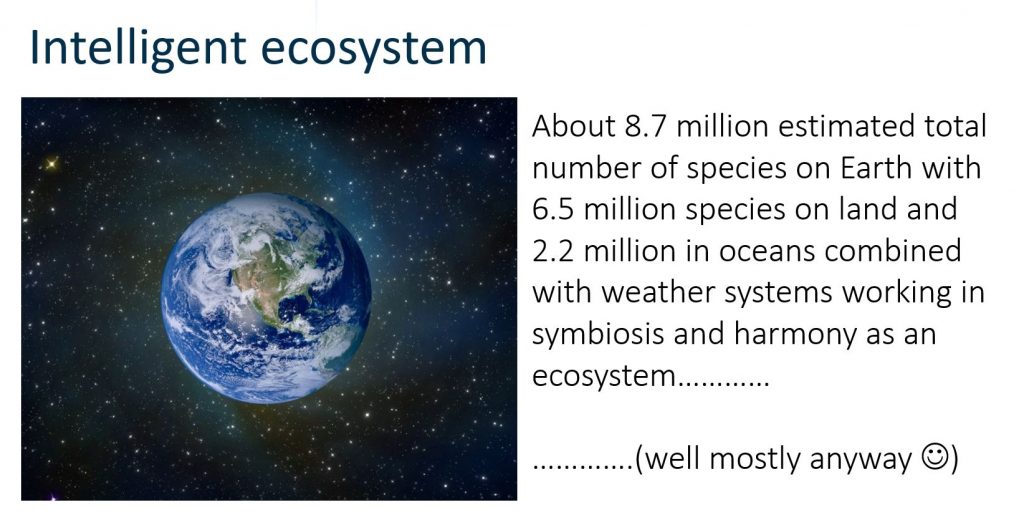For several years now I have been talking, lecturing and blogging on the similarities and synergies between natural and technological ecosystems.
There are so many examples where the best way to craft a technical solution has been to look at what nature has evolved to do over billions of years and then tweak it to meet our needs. Adopting nature’s examples effectively can then allow us to skip a lot of the learning and move straight to creating value.
Some of the very best examples of this right now are in artificial intelligence. Deep learning neural network techniques, such as recurrent or convolutional neural networks, essentially solve problems by mimicking evolved nature.
In his book Life 3.0, Max Tegmark summed this up perfectly: Just as most digital computers gain efficiency by splitting their work into multiple steps and reusing computational modules many times, so do many artificial and biological neural networks.
In that one line, he has put biological and artificial learning systems into the same category: brains. I think the fourth industrial revolution may result in similar advances for the Internet of Things.
Rethinking the IoT
In the loosest possible way, an IoT device is essentially any device connected directly or indirectly to a data-transmitting network, private or public (such as the internet). The optimum value that you can get from your connected devices is some level of automated, enriched, intelligent insights. This “artificial intelligence” must logically become more valuable than the sum of its constituent, connected parts (just like in an ecosystem).
If we hold all that to be true, then we can say that the key driver for the IoT is really AI or, as SAS COO Oliver Schabenberger describes it, the Artificial Intelligence of Things.
What does the world need to do to make the AI of Things a reality that saves time, electricity, resources and even maybe lives?What does the world need to do to make the AI of Things a reality that saves time, electricity, resources and even maybe lives? It is certainly not a matter of just dropping some analytics into data flows, as many have found in recent years. It is also not possible for a single person or company to engineer everything that is needed to make it a success, though many businesses have already tried that.
In fact, there are countless examples out there of hardware companies trying to become software companies, banks trying to become software companies, software companies trying to become hardware vendors and then maybe selling us gadgets and coffee machines. Most, with a few (very big name) familiar exceptions, do not succeed. And even some of those familiar names, such as IBM, Facebook and Uber, have gone back to the drawing board on many of their plans for AI and IoT. Why is that?
Because as the natural world discovered long before humans even existed, it is a much better value to build ecosystems.
Create and sustain true value from diverse IoT data and initiatives with AI and analytics. Download the AIoT White Paper.
Exploring ecosystems
Let’s take the Earth as an example of a complex ecosystem on a massive scale:
Each and every species of life on our planet has evolved its own specialisations. The combination of all those species and elements together, in balance, is what makes the planet successful and sustainable (as long as everything behaves as it should, of course).
Another example of an ecosystem on a smaller scale is the human body:
Each cell has its own specialised function, and the body also works with external organisms such as our gut bacteria, which help us to break down and distribute food. If you get the wrong kind of bacteria in your gut, however, we all know what happens, and it’s not pretty.
Successful ecosystems, then, usually have a fine balance, developed over a long period of time, with highly specialised constituents drawn from multiple sources. It is starting to look like we can say the same about the IoT as well.
There are many examples of ecosystems that work together for the benefit of all, but don’t confuse an ecosystem for a partnership or alliance; they are really quite different things. For example, if a partnership fails, each party just moves on and finds new partners, and pretty much everything continues as before. If members of an ecosystem fail, it could result in a catastrophic disaster (and in nature, at least, even death) for all the parties involved.
The natural world even has a model for us to use to describe the types of relationships that exist in this definition of an ecosystem: symbiosis. And it’s my view that the IoT is a type of symbiosis called mutualism.
A focus on specialisation and collaboration
In recent years, the business world has started to recognise that for AI and IoT to be successful, they must be mutually beneficial ecosystems, with each contributor focusing on its specialisation, in a symbiotic relationship that creates value that is far greater than the sum of all the parts.
SAS is staying focused on what it does best, providing our analytics and its supporting software wherever it is needed from edge to enterprise, with the robust engineering that our customers have come to expect of us over the last 40-plus years. We are not, however, working in isolation. Instead, we work in symbiotic relationships with like-minded companies, all around the world, including GE, Octo, SciSports, Intel and Cisco, to mention just a few.
This type of evolution in action and thinking is key to the future success of AI and IoT. I would perhaps go even further and say that only by businesses working this way will humans be able to harness the full value promised by the AI of Things in this fourth industrial revolution.
P.S. SAS will never build a machine to make your coffee, but we may well be the AI engine on that machine, learning to make that coffee taste better for you!



1 Comment
Really no matter if someone doesn't be aware of then its up to other users that they will help, so here it occurs.